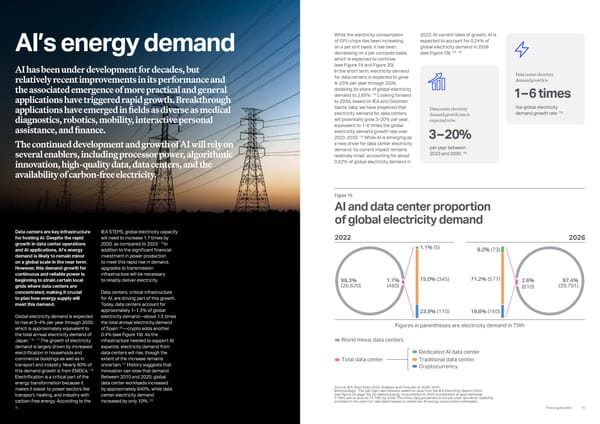Data center electricty demand growth rate is expected to be per year between 2023 and 2030 124 3 – 20% Data center electricty demand growth is the global electricity demand growth rate 124 1 – 6 times AI has been under development for decades, but relatively recent improvements in its performance and the associated emergence of more practical and general applications have triggered rapid growth. Breakthrough applications have emerged in fields as diverse as medical diagnostics, robotics, mobility, interactive personal assistance, and finance. The continued development and growth of AI will rely on several enablers, including processor power, algorithmic innovation, high-quality data, data centers, and the availability of carbon-free electricity. While the electricity consumption of GPU chips has been increasing on a per unit basis, it has been decreasing on a per compute basis, which is expected to continue (see Figure 19 and Figure 20). In the short term, electricity demand for data centers is expected to grow 8–23% per year through 2026, doubling its share of global electricity demand to 2.65%.123 Looking forward to 2030, based on IEA and Goldman Sachs data, we have projected that electricity demand for data centers will potentially grow 3–20% per year, equivalent to 1–6 times the global electricity demand growth rate over 2023-2030.124 While AI is emerging as a new driver for data center electricity demand, its current impact remains relatively small, accounting for about 0.02% of global electricity demand in AI’s energy demand Figure 18 AI and data center proportion of global electricity demand Source: IEA, Electricity 2024: Analysis and Forecast to 2026, 2024 Methodology: The pie chart was develop based on data from the IEA Electricity Report 2024 (see figure on page 35), AI-related energy consumption in 2022 is estimated at approximately 5 TWh, and at around 73 TWh by 2026. The other data presented in the pie chart are either explicitly provided in the report or calculated based on these two AI energy consumption estimates. Traditional data center Dedicated AI data center Total data center Cryptocurrency 1.1% (5) 23.9% (110) 19.8% (160) 2.6% (810) 97.4% (29,791) 98.3% (26,620) 1.7% (460) 71.2% (577) 9.0% (73) 2026 2022 75.0% (345) Figures in parentheses are electricity demand in TWh World minus data centers 2022. At current rates of growth, AI is expected to account for 0.24% of global electricity demand in 2026 (see Figure 18).125, 126 Data centers are key infrastructure for hosting AI. Despite the rapid growth in data center operations and AI applications, AI’s energy demand is likely to remain minor on a global scale in the near term. However, this demand growth for continuous and reliable power is beginning to strain certain local grids where data centers are concentrated, making it crucial to plan how energy supply will meet this demand. Global electricity demand is expected to rise at 3–4% per year through 2030, which is approximately equivalent to the total annual electricity demand of Japan.116, 117 The growth of electricity demand is largely driven by increased electrification in households and commercial buildings as well as in transport and industry. Nearly 80% of this demand growth is from EMDCs.118 Electrification is a critical part of the energy transformation because it makes it easier to power sectors like transport, heating, and industry with carbon-free energy. According to the IEA STEPS, global electricity capacity will need to increase 1.7 times by 2030, as compared to 2023.119 In addition to the significant financial investment in power production to meet this rapid rise in demand, upgrades to transmission infrastructure will be necessary to reliably deliver electricity. Data centers, critical infrastructure for AI, are driving part of this growth. Today, data centers account for approximately 1–1.3% of global electricity demand—about 1.5 times the total annual electricity demand of Spain120—crypto adds another 0.4% (see Figure 18). As the infrastructure needed to support AI expands, electricity demand from data centers will rise, though the extent of the increase remains uncertain.121 History suggests that innovation can slow that demand. Between 2010 and 2020, global data center workloads increased by approximately 840%, while data center electricity demand increased by only 10%.122 72 Powering Possible 71
 Powering Possible 2024: AI and Energy for a Sustainable Future Page 36 Page 38
Powering Possible 2024: AI and Energy for a Sustainable Future Page 36 Page 38